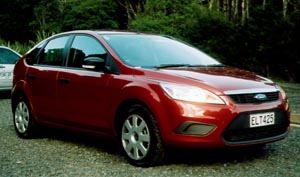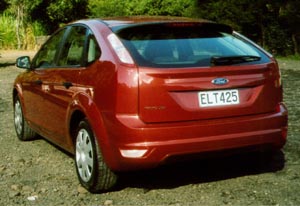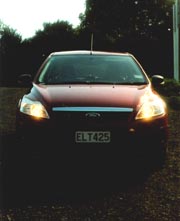|
living:
autocade
 Ford Focus—base points Ford Focus—base points
Jack Yan samples the basic two-litre Ford Focus, and says that as long
as the company can keep sourcing great cars from Europe, it might gain in street
cred


ALTHOUGH I’VE
BEEN DRIVING plenty of luxury brands this year, I needed
a dose of reality. The Ford Focus seemed a fitting car to trial
in a year when Ford celebrates the centenary of the Model T, since
it is the most widely sold nameplate* from the company and it is
aimed directly at the middle class.
In 1987, Ford created a show car, for the far-off year
of 2008, to celebrate this very centenary in advance. The T2008,
looking like it belonged to the set of Back to the Future Part
II or Blade Runner, had a satellite communications’ system
that could notify a dealership of any problems. Fast forward 21
years and sat-nav isn’t standard on the basic two-litre Focus sold
in New Zealand, and wifi in Auckland is variable near where John
Andrew Ford is, but as the modern-day successor to the Model T,
the car takes some beating. At the price, it’s untouchable.
Last time we featured the Focus in Lucire’s
pages (in 2005), we necessarily drew comparisons to the Capri and
Bodie and Doyle in The Professionals, because of the Zetec’s
differently coloured trim on the doors. Very wannabe Essex boy racer.
This time, with a lower-end model on test—one destined for fleet
sales, in fact—things are more subdued, but the interior has lovely
touches that give you more pleasure than its predecessor. Get high
enough in the range and the Ford Focus would, to borrow from its
advertising campaign, be a car one could take to the symphony.
You couldn’t say the same thing about Fords of old.
My uncle had a yellow Cortina Mk III 1300L. Registration HW
7322. It was about as ‘fleet sale’ as you could get, short
of buying a Morris Marina. You knew you were in the base model because
it didn’t have a vinyl roof or four headlamps like Gene Hunt’s GXL
from Life on Mars, or the oh-so-modern square headlamps of
the 2000E. Inside, it was just a car—which was really all my
uncle wanted—but it had little to redeem it. It handled like
a pig. Today, however, even the basic model has some creature comforts,
even if there’s one concession to those who bought Cortina 1300s
in the ’70s: wind-up rear windows.
Despite this, the plastics aren’t a smelly, stinky
grade as Opel had put in its Polish-built Astra Classic some years
ago—probably the lowest end Lucire would judge interior materials
by this side of the 21st century.
The Focus, built in Saarlouis near Köln, certainly
seems better screwed together inside. The quality of the plastics
is a step up, and even the steering wheel is more æsthetically
pleasing. The information screen between the speedometer and rev
counter gives off a warm, orange glow.
You’d upgrade from a previous model not specifically
for the quality, but for the grown-up feel of the exterior. It might
be worth it, too. From the front, it looks very Mondeo, bringing
the Focus bang up to date with current trends. Ford calls it kinetic
design, which is the new buzzword after a few years of what
it called New Edge and a few years of the aero look.
This time, however, it’s less contrived: the designers have made
the car look easily identifiable as a Ford from the front without
going against what we find attractive. Even at the rear, the resculpted
rear hatch looks more high-end. Overall, there’s a more premium
feel, borrowing from more upmarket Fords.
In fact, everything is very familiar to those of us
who have driven Focuses in the past.
These are all Ford techniques used over the years.
Each year or two, Ford has upgraded its equipment on an existing
car by means of improvement. Facelifts, such as the change from
Taunus II to Taunus 80—Cortina Mk IV to Cortina 80 to those of us
in the Commonwealth—make the newer model look more upscale by borrowing
from a higher model; that time, it was the Granada, now it is the
Mondeo. BMW learned this and began
employing the same technique from the late 1980s, changing first
its 7-series, then its 5, then its 3. It clearly works.
So the shape is familiar, and one would have to ask
if purchasing a new Focus keeps one up with the Schmidts and their
Golf. Dynamically, the answer is yes. The Focus handles as it always
did—brilliantly—and we’d place it easily above the Opel Astra H,
sold here as a Holden with the indicator stalk on the wrong side.
It rides well though at this trim level, there is some road noise—however,
it’s an improvement on the previous C307 Focus. We’d rate the
Focus above the Toyota Auris (Corolla to us), thanks to an exterior
that is less likely to date and an interior that’s still streets
ahead æsthetically. The real competition comes from the French—we
are big fans of the Renault
Mégane and Citroën C4—which have the Focus’s torque
(more so with the Mégane) and agility.
In that respect it is down to the badge. Citroën
and Renault mean French flair; Toyota means very little (now that
Barry Crump is dead); Holden increasingly means Made in Korea (the
Astra is an exception); and Ford means German quality at cheap prices.
The only real reason that one would go Golfing is the
Levi jean image of the VW. Since the
Golf VI has not launched in these parts yet, the Focus is far better
value, especially now a 1·6 is available, too. Even when Golf VI
comes, the Focus is going to fight it strongly, thanks to that upgrade
that makes it Ford’s most class-crossing car.
It might not be a default choice like the Model T was
in its day, but driving a Focus means a trip down Quality Street,
even at the base end of the range. It’s more grown-up, more
adult. And since Ford, unlike Holden, hasn’t populated its range
with Daewoos, and instead has opted for sourcing everything in its
passenger car range (aside from Falcon) from Europe, it might begin
earning a more premium, old-world image to go with what is very
good engineering indeed. •
* Note I said nameplate. The US–Canada
Focus is a different car, actually the Mk I with new clothes.
It’s barely worth a mention except for the bad excuse Ford’s North
American operations makes about the Mk II’s high costs. Cobblers,
say the Mexicans, who, like the rest of the world, thought that
the US model was beneath them and got the second-generation one.
Jack Yan is founding publisher of Lucire.
Add
to Del.icio.us | Digg
it | Add
to Facebook
|

Get high
enough in the range and the Ford Focus would, to borrow from its
advertising campaign, be a car one could take to the symphony
Off-site links

• Get
more information about the Ford Focus (C307) on Autocade
• Ford New Zealand
|

